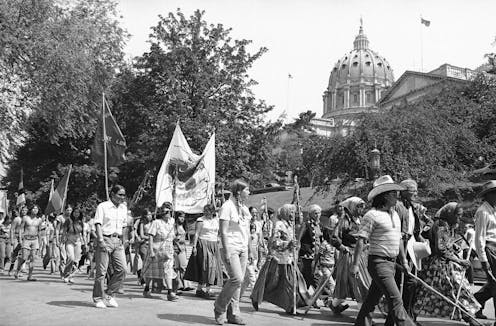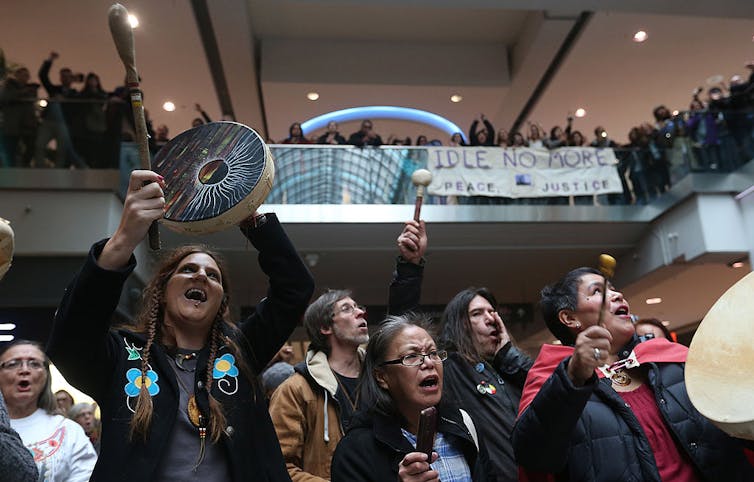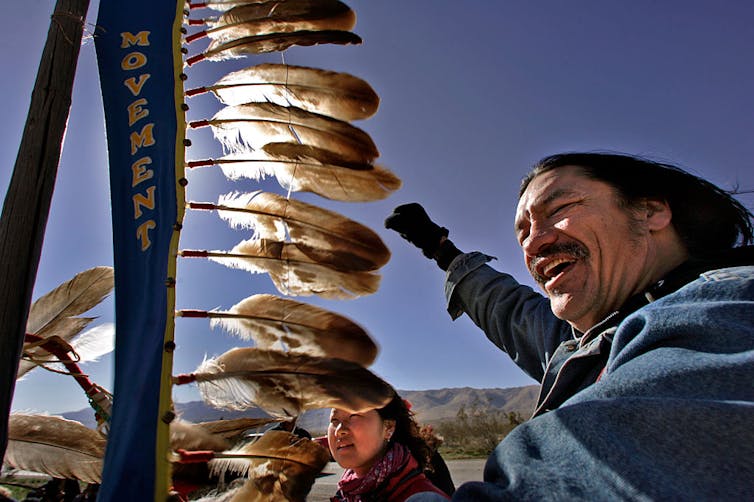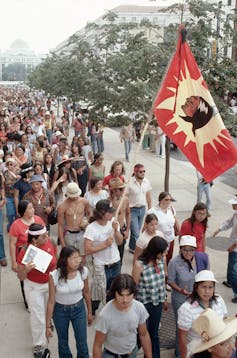Activism on foot: When Indigenous activists walk the land to honor their past and reshape their future
- Written by Meaghan Weatherdon, Assistant Professor of Theology and Religious Studies, University of San Diego
 Native Americans taking part in the Longest Walk, heading from San Francisco to Washington, D.C., march past the state Capitol in Harrisburg, Pa., in 1978. AP Photo/Prouser
Native Americans taking part in the Longest Walk, heading from San Francisco to Washington, D.C., march past the state Capitol in Harrisburg, Pa., in 1978. AP Photo/ProuserMore than a decade ago, I spent a week working in Gatineau, a city on the southern edge of Québec, with the Cree Board of Health and Social Services. I was helping train researchers to interview Iiyiyiu elders about traditional birthing knowledge, so they could develop resources for soon-to-be parents and health care workers.
Throughout our workshop, my colleagues in the Cree Nation of Iiyiyiu Aschii shared their excitement about a “great journey” their youth were undertaking: the Journey of Nishiyuu. A group was traveling 1,000 miles on foot in the dead of winter – all the way from their homes in Whapmagoostui First Nation, on the shores of Hudson Bay, to Parliament Hill in Ottawa, the capital of Canada.
For Indigenous activists, walking the land can take on powerful spiritual and political significance. It has been, and continues to be, an important way Indigenous nations pursue healing, environmental stewardship and diplomacy across Turtle Island, the name many Indigenous groups use to refer to North America.
I am a Canadian scholar whose ancestry stems from Western Europe. I now teach in San Diego, on Kumeyaay territory. My scholarship focuses on Indigenous spiritualities and social movements. Over the past several years, I have worked with Whapmagoostui First Nation – a remote, fly-in community in northern Québec – on research about the Journey of Nishiyuu.
Healing journey
The Journey of Nishiyuu – which translates to"human beings" or “new people” – took place from January-March 2013. More broadly, that season was known as the winter of Idle No More, a movement in support of First Nations’ rights in Canada.
Led by Indigenous women, Idle No More arose when the Canadian government passed C-45, legislation that they feared would reduce environmental protections and weaken consultation with Indigenous communities. The winter of 2012-13 was also when Theresa Spence, the chief of Attawapiskat First Nation, held a hunger strike near Parliament Hill – an effort to hold the government accountable for its treaty obligations and to address the inadequate living conditions in northern reservations.
 Activists in the Idle no More movement stage a flash protest inside the Eaton Centre in Toronto on Dec. 30, 2012.Steve Russell/Toronto Star via Getty Images
Activists in the Idle no More movement stage a flash protest inside the Eaton Centre in Toronto on Dec. 30, 2012.Steve Russell/Toronto Star via Getty ImagesThe Nishiyuu walkers announced that they were walking the land to demonstrate that the Iiyiyiuch are still “keepers” of their “language, culture, and tradition,” and honoring their ancestors. Many individual walkers also spoke about the experience as a healing journey.
“For the youth here there is no better place to be than out on the land,” said David Kawapit, the young walker who initiated the journey, when I interviewed him in Whapmagoostui.
The walkers started off their journey in snowshoes, traveling along traditional trap lines and trading routes. As they moved farther south, the trail turned to highways, and walkers exchanged moccasins and snowshoes for boots and running shoes. Throughout the journey, walkers were hosted by other Iiyiyiu, as well as other Indigenous and non-Indigenous communities, where they shared stories, food and prophecies with one another.
When the group set off in January, it consisted of only six young walkers from Whapmagoostui and their elder guide, the late Isaac Kawapit. By the time they reached Parliament Hill, however, the movement had grown to approximately 270 people of many ages and cultural backgrounds.
This was not just a walk for the Cree Nation. The journey was also intended to strengthen inter-Indigenous relations across Canada during Idle No More. The Nishiyuu walkers embarked on their journey to emphasize the important role land plays in shaping their sense of well-being, their culture and their communities’ political autonomy.
The Journey of Nishiyuu.Walking land and lakes
The Journey of Nishiyuu is one of many Indigenous-led social justice movements that engage in walking the land. In 1978, for example, the American Indian Movement led a 3,000-mile walk from Alcatraz Island in San Francisco all the way to Washington, D.C.
Activists who participated in this “Longest Walk” did so to hold the U.S. government accountable to its treaty obligations. The United States signed approximately 374 treaties with Indigenous nations from 1778 until 1871, but Native American groups argue the government has often eroded rights these treaties were meant to protect.
The Longest Walk helped prevent the passage of 11 bills in Congress that would have restricted Native communities’ jurisdiction and social services and diminished their land and water rights, among other consequences.
In 2008, Indigenous activists embarked on a second Longest Walk and once more made the long journey from Alcatraz to Washington. This time, the walkers called attention to the need to respect sacred sites, protect the environment and create better futures for young people.
 Nathan LeRoy, who was part of the original Longest Walk, takes part in the 2008 recreation of the walk from San Francisco to Washington, D.C.Irfan Khan/Los Angeles Times via Getty Images
Nathan LeRoy, who was part of the original Longest Walk, takes part in the 2008 recreation of the walk from San Francisco to Washington, D.C.Irfan Khan/Los Angeles Times via Getty ImagesOther walks have brought together Indigenous activists from Canada and the U.S., such as the Mother Earth Water Walkers. The late Josephine Mandamin, an Anishinaabe Grandmother and member of Wikwemikong First Nation, initiated the first Water Walk on Easter morning in 2003. She walked the entire perimeter of Lake Superior, on the U.S.-Canada border – an act of prayer and an effort to live out her obligations to care for and heal the waters.
Mandamin was joined by other “water walkers” who have kept her traditions and teachings alive. They have continued to walk around numerous bodies of water, including Lake Ontario in 2006, Lake Erie in 2007 and the Menominee River in 2016. Their walks embody an Anishinaabe perspective that water is a sacred medicine, and also aim to educate the public on the importance of Indigenous peoples’ access to water and jurisdiction over their ancestral waterways.
Affirming freedom
When Indigenous activists walk the land, they are restoring their firsthand knowledge of place and reknitting their relationships with plants, animals and other human beings. They are also revitalizing traditional forms of governance and diplomacy through visits with other Indigenous nations along the way – and sometimes inviting non-Indigenous people to walk with them. These invitations offer non-Indigenous walkers opportunities for reconciling their own relationships to land and to the Indigenous peoples whose territories they inhabit.
 American Indian Movement members involved in The Longest Walk trek along the Mall in Washington, D.C., in 1978.Wally McNamee/Corbis via Getty Images
American Indian Movement members involved in The Longest Walk trek along the Mall in Washington, D.C., in 1978.Wally McNamee/Corbis via Getty ImagesPart of such walks’ significance stems from history. For centuries, the United States and Canada attempted to control Indigenous peoples’ freedom of movement – often with support from religious institutions. In the U.S., the reservation system segregated Indigenous nations and allocated them to small portions of land. In Canada, the pass system mandated that Indigenous people present a travel document to an appointed Indian agent in order to leave and return from their reservations.
Boarding schools in the United States and residential schooling in Canada separated children from their lands, families and communities. Federal relocation programs encouraged or forced Indigenous people to move to cities and urban centers in an attempt to assimilate them.
While these social movements commemorate history, and try to heal from it, they are also a reminder that the past is present.
By walking the land, Indigenous people assert their sovereignty and carry out their sacred obligations to care for their lands and waters – which I believe can inspire a more just and beautiful future.
Meaghan Weatherdon has received funding from the Social Sciences and Humanities Research Council of Canada, the Northern Scientific Training Program, the Ontario Graduate Student Scholarship fund, the Association of Canadian Universities for Northern Studies, the University of Toronto, and the University of San Diego. She has also received support from Whapmagoostui First Nation Youth Council through her participation as a mentor in the youth work experience program.
Authors: Meaghan Weatherdon, Assistant Professor of Theology and Religious Studies, University of San Diego

